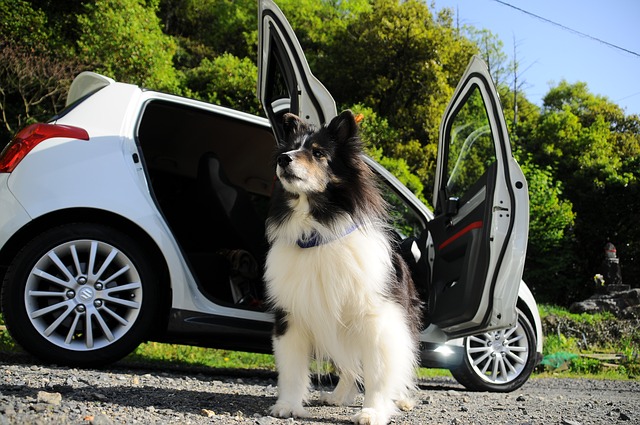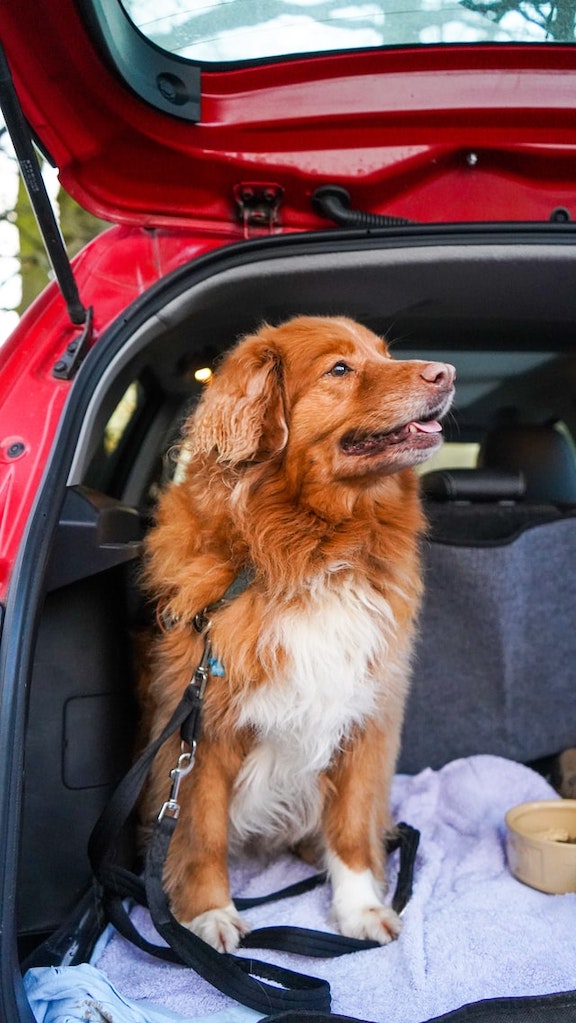6 Essential Tips for a Safe Road Trip With Your Dog
Posted: 11/06/2023 | BY: Erin Cain | Categories: Uncategorized
With summer on the horizon, you may already be planning your road tripping excursions. While some pup parents choose to leave their dog with relatives, arrange for a dogsitter, or board their dog during their trip, more owners decide to bring their dog with them on their adventures. Having your pup at your side while you travel can be one of the most fulfilling experiences for both you and your dog. However, before you start on your journey, you’ll want to learn these 6 essential tips for a road trip with your dog.

1. Practice ahead of time.
If your dog has never been on a road trip or hasn’t traveled in some time, a travel refresher and practice session may be in order. For small puppers traveling in a carrier or pet car seat, set out their crate or seat a few days ahead of time to teach your dog that the carrier is a fun, safe space. Leave the carrier door open and feed your dog in it on occasion; let her develop a positive association with it. Practice entering and exiting the carrier, so it becomes second nature to your dog when you start your trip.
For large dogs, make sure there is plenty of space in the vehicle for them to feel comfortable. They shouldn’t be cramped or forced to work around a car packed with other travel items. Additionally, a canine seat belt and harness are must-have safety options to keep your dog safely restrained while the car is in motion. With this tool, your dog will have some room to move, but not enough to go flying through a window during a hard stop.
No matter the size of your dog, spend some time introducing her to car rides if she’s not already familiar with them. Take a few shorter test drives and let your pup get accustomed to the sound and feel of the vehicle. Be prepared for bouts of car sickness and anxiety; with more practice and positive associations with rewards, your dog should overcome her hesitation. Also, plan for plenty of potty breaks on the journey; you will cut down the possibility of accidents in the middle of a long road trip.
2. Pack for your dog’s needs.
Taking your pup on the road means packing a bag for her, too. No matter where you are going or how far you’ll travel, you want to have these items with you for your dog:
- Food and treats in zip-lock baggies
- Collapsible water and food bowls
- Collar and harness
- Safety seat belt or car sea
- Carrier or crate for small dogs
- Back seat dog hammock for large dogs
- Leash
- Bottled water
- Poop bags
- Toys
- Collapsible crate for hotel rooms
- Dog first-aid kit
- Up-to-date tags and contact information
- Bedding for the car and the hotel
- Paper towels
- Disposable gloves for cleanup
- Current veterinarian and vaccination records
If your dog’s anxiety or car sickness persists, consider a swaddling shirt or vest or pheromone calming collar to reduce anxiety. Talk to your veterinarian about appropriate medications to control your pup’s car sickness on your travels.

3. Puppy-proof your car.
Aside from a secure car seat or harness and seat belt, there are a few other steps to consider before pulling out of the driveway with your dog in tow. It’s essential to ensure your pup’s safety while you are driving, which means nothing — not head, tongue, or tail — of your dog should be hanging outside your car at any time. That iconic image of the dog sticking her head out the car window, enjoying the breeze, with tongue lolling, is heartwarming but, in reality, dangerous.
Some dogs can jump out the car window, and a dog can get thrown out the window in a collision. Other dogs who like to feel the wind in their faces may be hit by passing debris that could damage their eyes or mouth. If you have child-safety locks on your car windows and doors, use them when your pup is in the back seat. Check with your county or state legislature to see if your state requires your dog to be restrained in a vehicle with a safety belt and harness, crate, or carrier. Even if your state hasn’t passed a doggy seat belt law yet, you should make sure your dog is safe and restrained in the car while it’s in motion for both of your sakes.
Remember, you should never put or leave your dog in a hot car. Within minutes, your dog can overheat, endangering her life.

4. Check for dog-friendly locations.
Do some research on the places you plan to travel, so you don’t bring your dog to a location where she is not allowed. If you plan to stay with friends or family, check ahead of time to see if your dog is welcome company.
If hotels or motels are part of your trip, research the location’s pet policies on their website, or call their front desk to inquire about if or in what ways pets are allowed on the premises. Plenty of websites provide information about various of dog-friendly hotels, resorts, and all-around fun places for you and your pup to visit.
Remember, if your dog is traveling with you, plan for some activities that she can enjoy, too. Don’t bring your dog cross-country only to leave her in the hotel room or doggy day care the entire trip. What does your dog love best, aside from being in your company? Running on the beach? Hiking the trails? Camping out? Tailor your trip to include bonding time for you and your pup.
5. Be prepared for emergencies.
No one wants to think about an emergency when they’re on a road trip with their dog, but it’s best to be prepared should something unfortunate happen. Have the number of the nearest 24-hour emergency veterinary hospital programmed into your phone. In case the emergency vet needs it, have the name and contact information for your dog’s regular veterinarian, as both doctors may need to confer on your dog’s care and treatment.
Don’t forget a canine first-aid kit, the first line of defense against injury and infection in your dog. It’s a good idea to have one at home, too.
6. Have pet insurance in case of emergency.
What if your dog is injured during your road trip, and you take her to an emergency clinic? The average cost for an emergency clinic visit is roughly $1500, and much more in a life-threatening situation. You can ease the burden of those costs by purchasing a pet insurance policy for your dog. The yearly cost of a policy is well worth the coverage offered for pet emergencies. Get a free pet insurance quote, and make sure your pup will receive the best treatment should she be injured on your trip.
Hit the road, pup!
Taking a road trip with your best four-legged companion will lead to memories that will last a lifetime. Prepare, plan, be safe, and enjoy precious time with your beloved pup.
References:
- Shojai, A. (2021). How to Cure Car Sickness in our Dog. Retrieved from https://www.thesprucepets.com/cure-puppy-car-sickness-2804799
- Buzkardt, L. (2021). Anxiety Vests for Dogs. Retrieved from https://vcahospitals.com/know-your-pet/anxiety-vests-for-dogs
- Easter, F. (2016). Do Dog Pheromone Collars Work? Retrieved from https://www.dogtrainingnation.com/dog-behavior-2/do-dog-pheromone-collars-work/
- De La Harpe, T. (2019). Dog Seat Belt Law: Find Out if Your State Requires Dog Seat Belts. Retrieved from https://pawsafe.com/blogs/news/find-out-if-your-state-requires-dog-seat-belts
- Franklin Ranch Pet Hospital. (2019). The Facts About Dogs in Hot Cars. Retrieved from https://franklinpet.com/the-facts-about-dogs-in-hot-cars/
- Arford, K. (2019). Dog First-Aid Kit Essentials. Retrieved from https://www.akc.org/expert-advice/health/dog-first-aid-kit-essentials/
- Veterinary Practice News Editors. (2017). Petplan: Average cost for emergency care is $1500. Retrieved from https://www.veterinarypracticenews.com/petplan-average-cost-for-emergency-vet-care-is-1500/
Disclaimer
The information contained on this blog is intended for informational and educational purposes only and should not be construed as medical advice. It is not a substitute for professional veterinary care. Always consult with your veterinarian before making any changes to your pet's health care or treatment plan.
The authors of this blog are not veterinarians and do not claim to be experts in pet health. The information provided here is based on our own experiences and research, as well as information from reputable sources. However, we cannot guarantee the accuracy or completeness of this information.
We encourage you to do your own research and consult with your veterinarian before making any decisions about your pet's health.
Previous post
Tips On Choosing Cat FoodCompare top pet insurance providers plans.
Enter your dog’s age in years and months to calculate their age equivalent to human years.
Calculate your dog’s ageEnter your cat’s age in years and months to calculate their age equivalent to human years.
Calculate your cat’s age